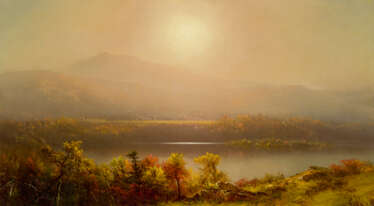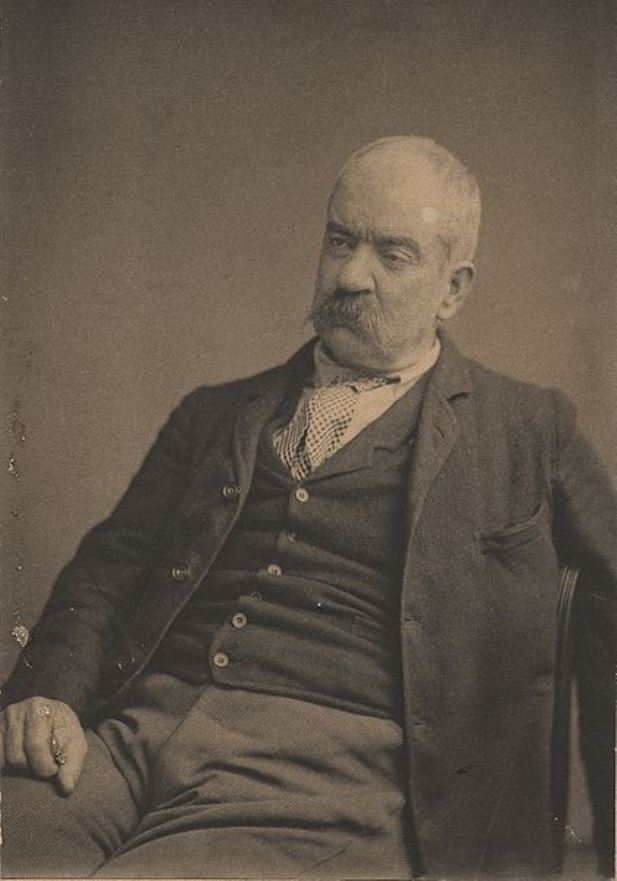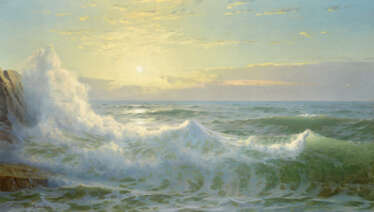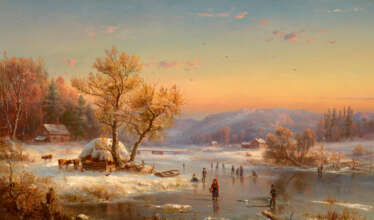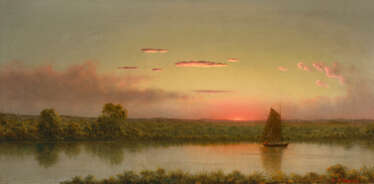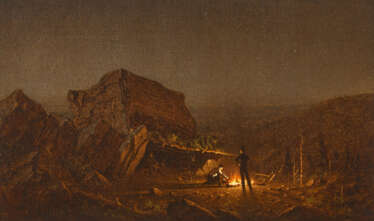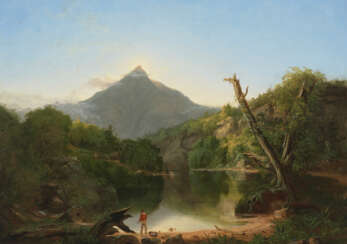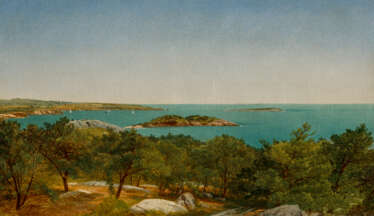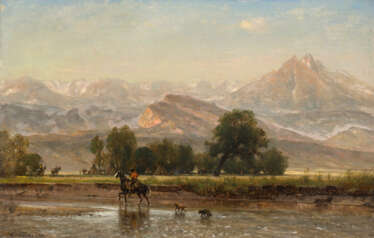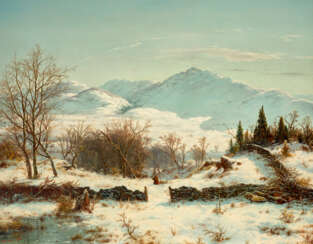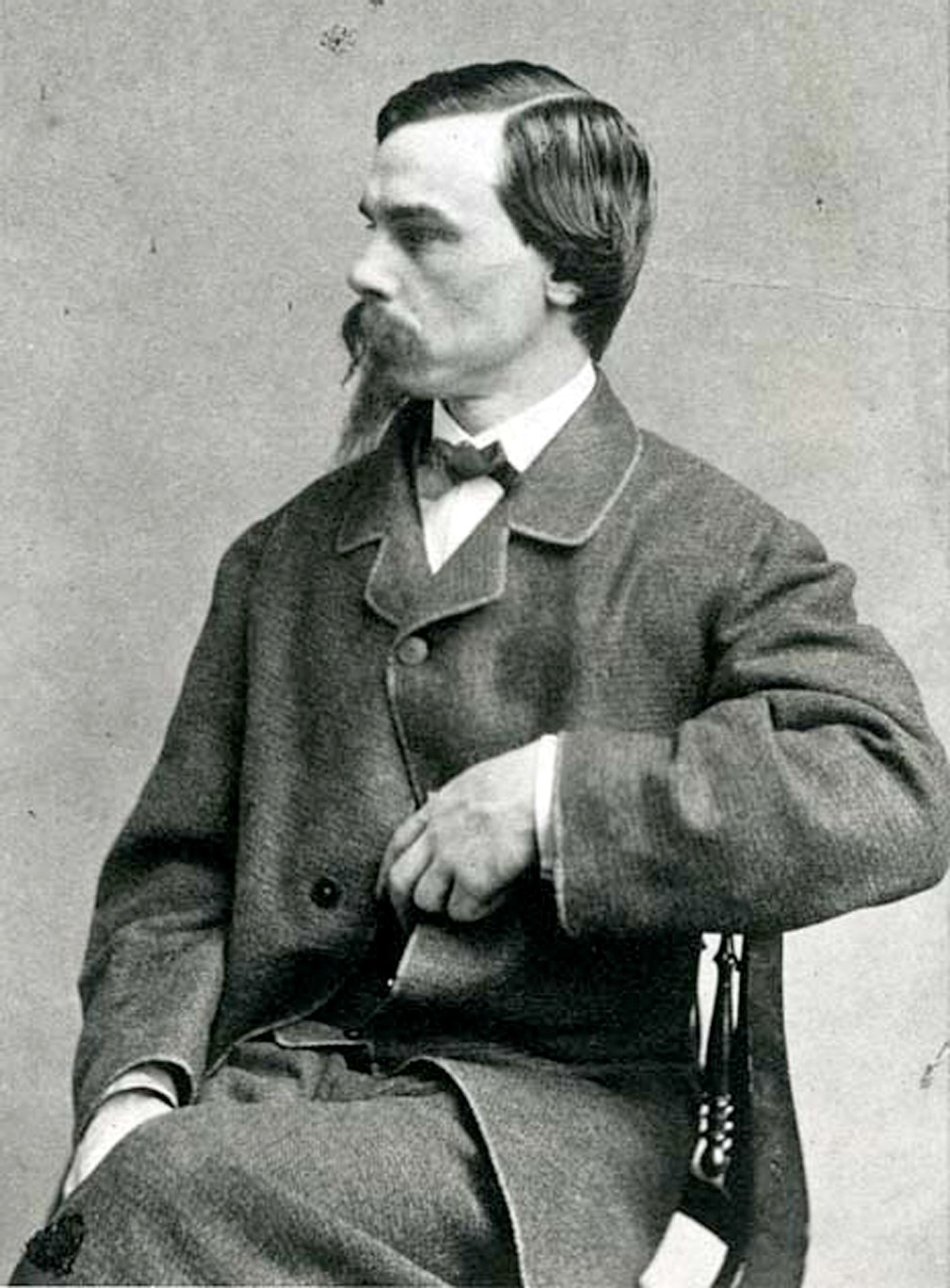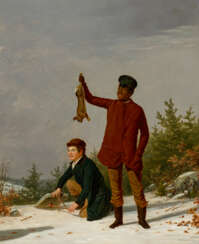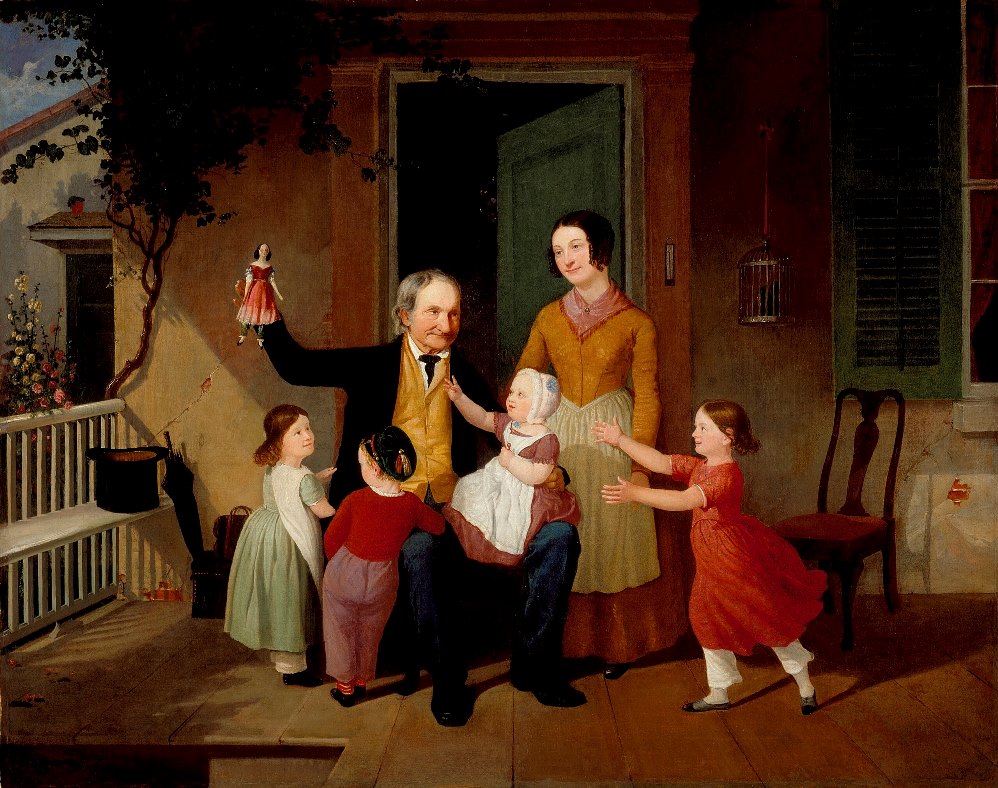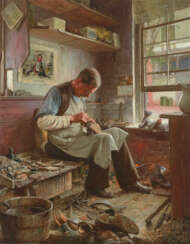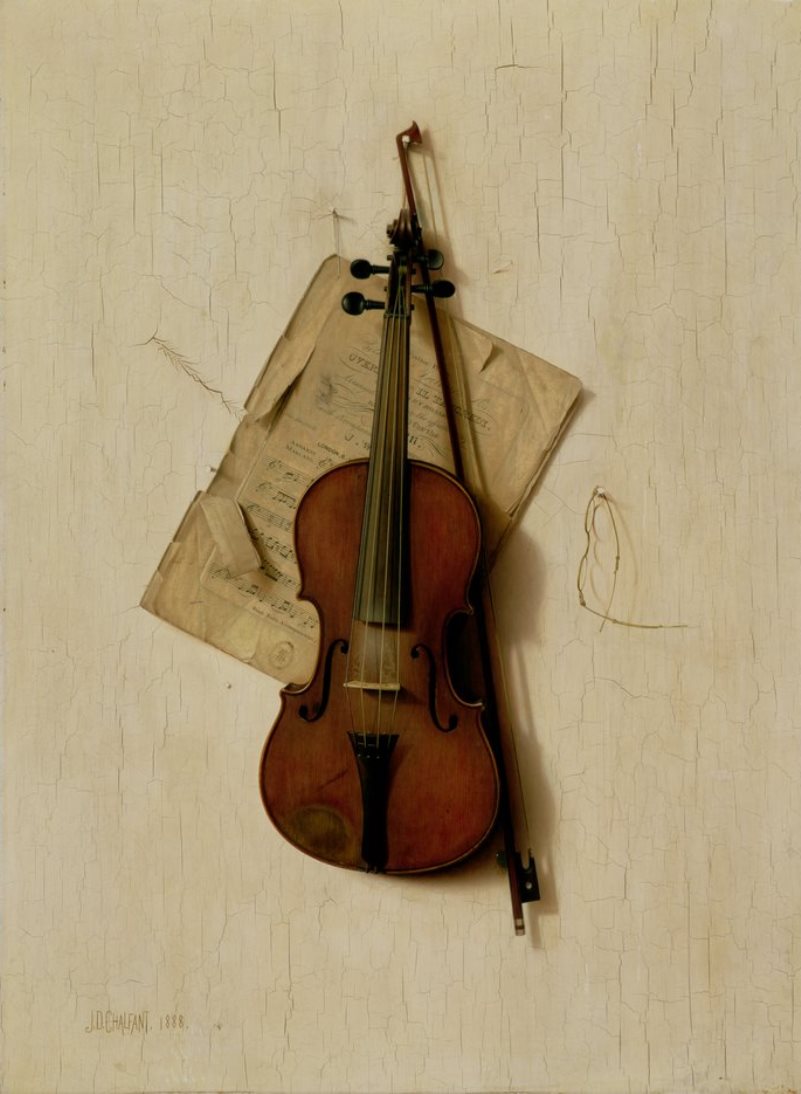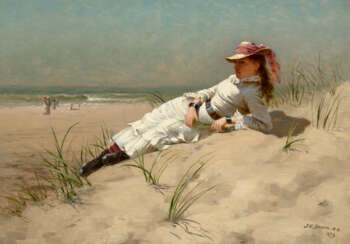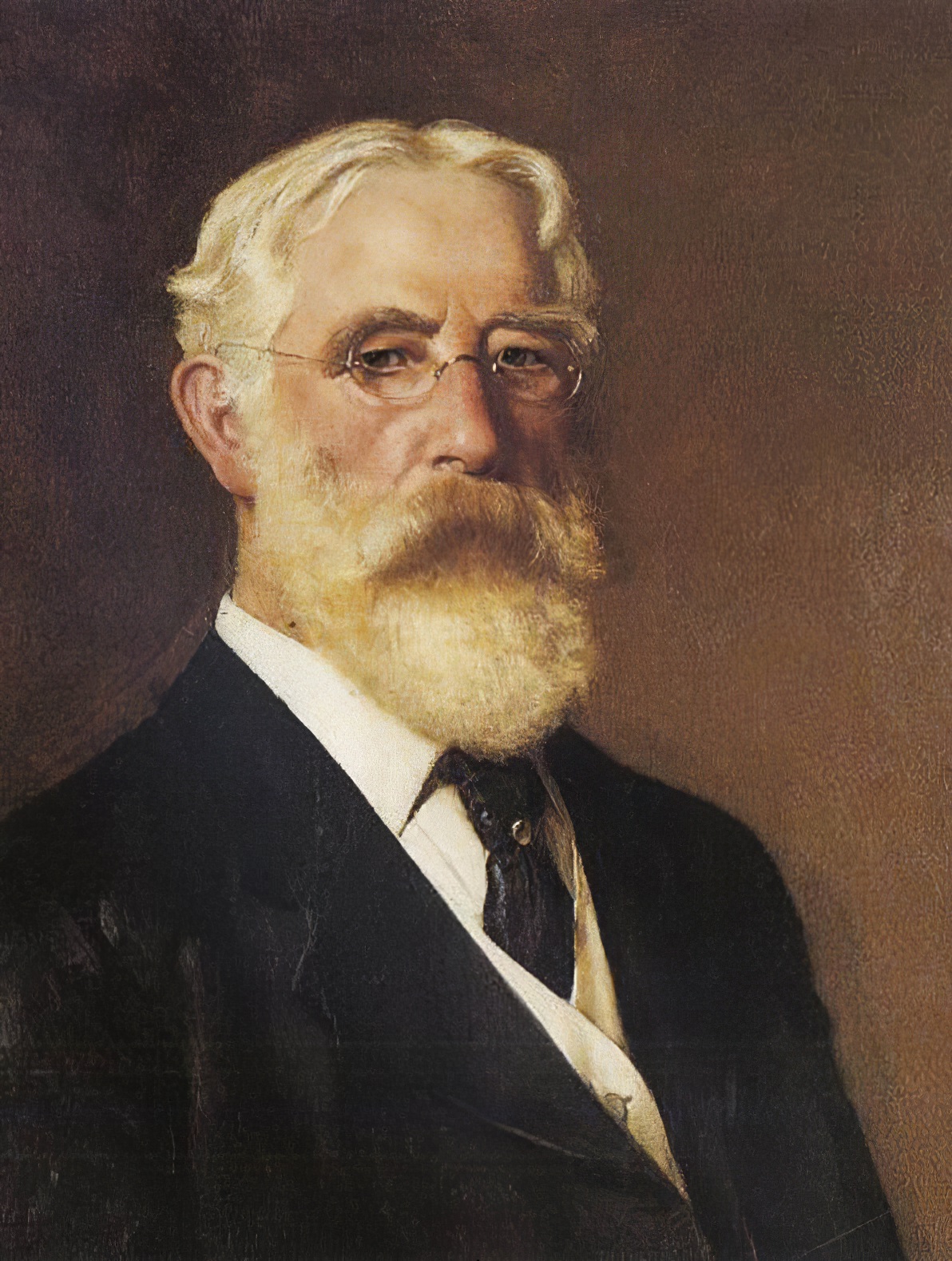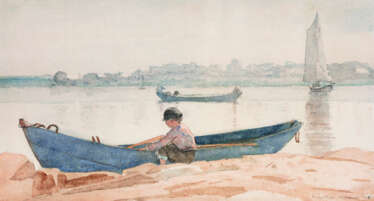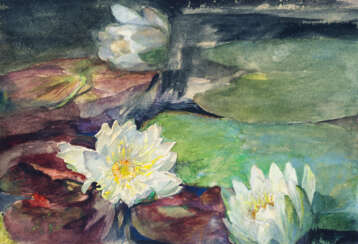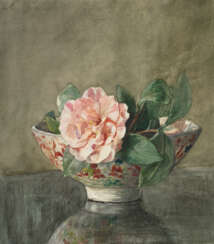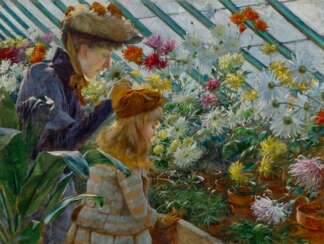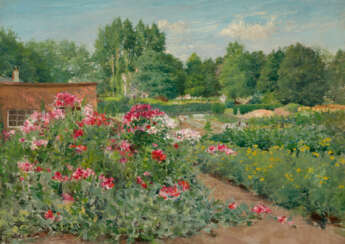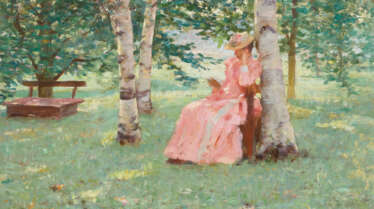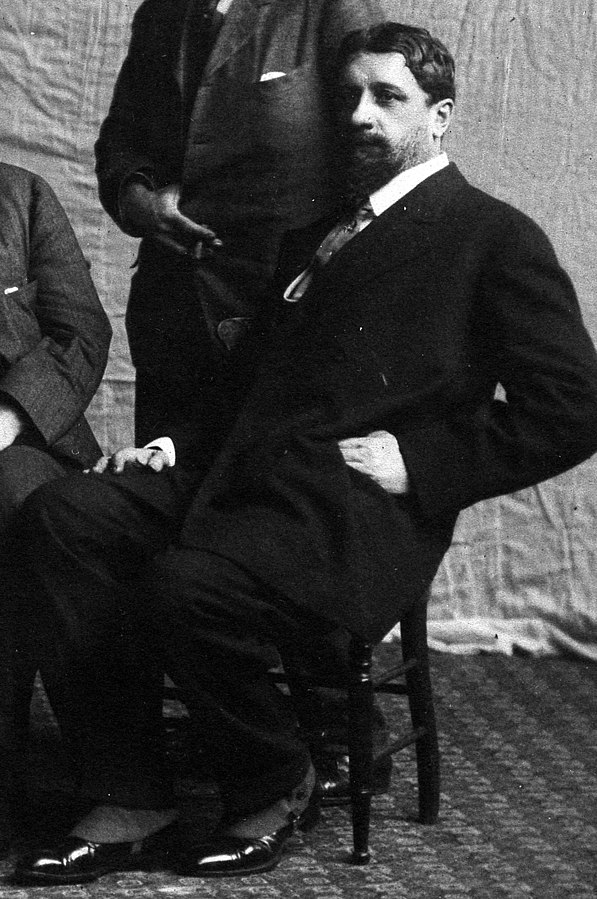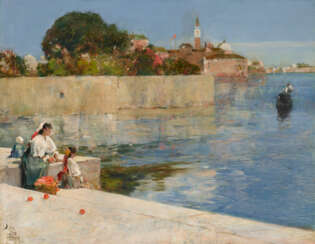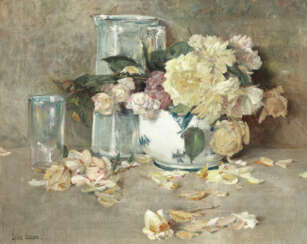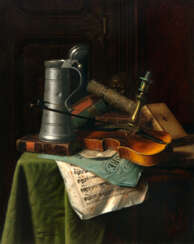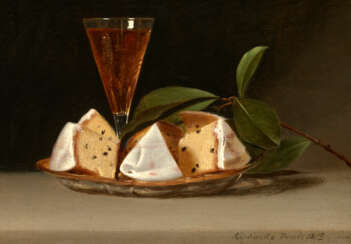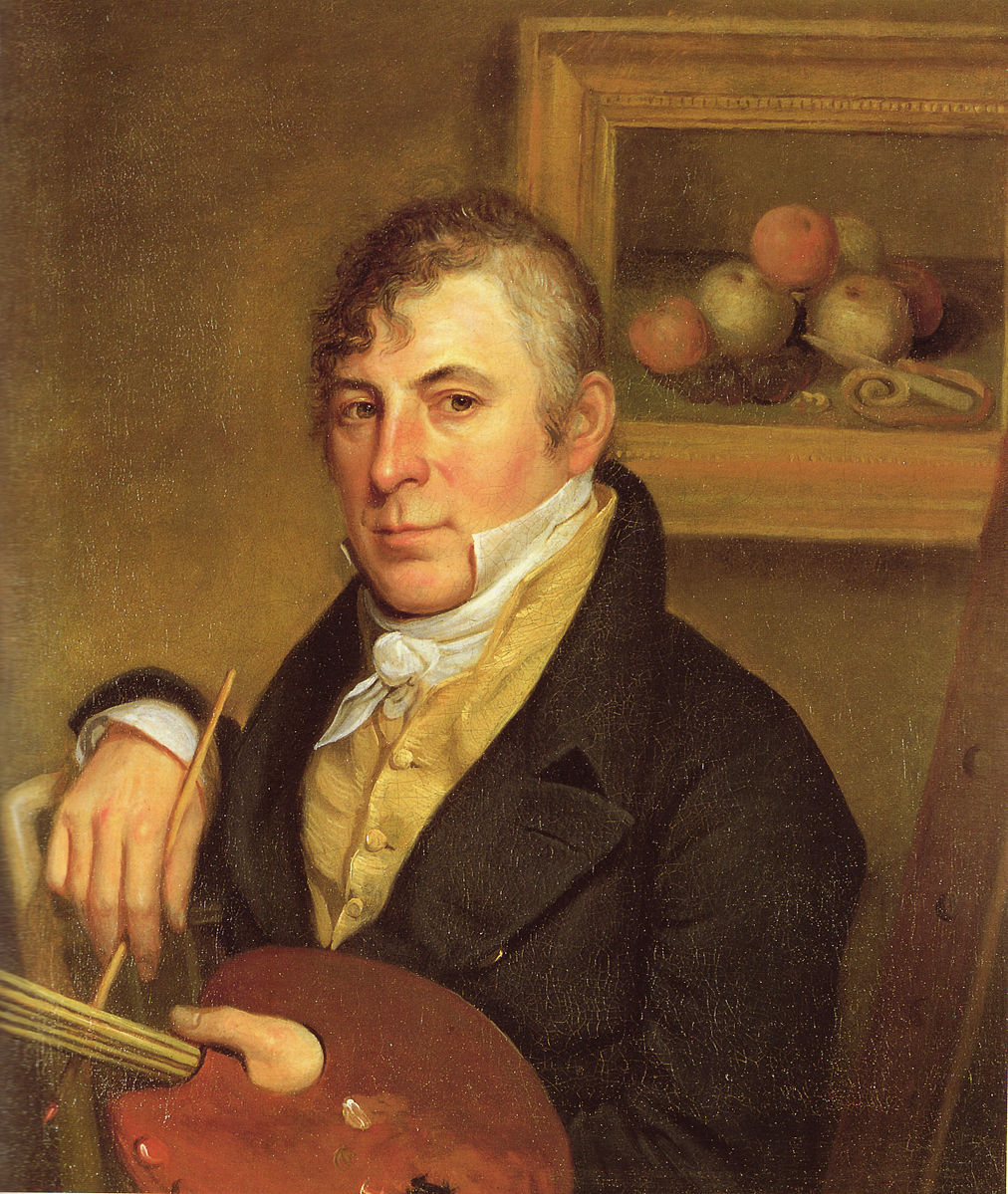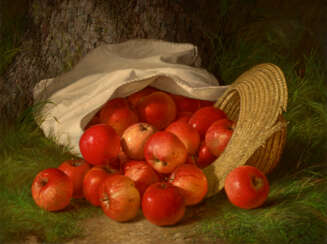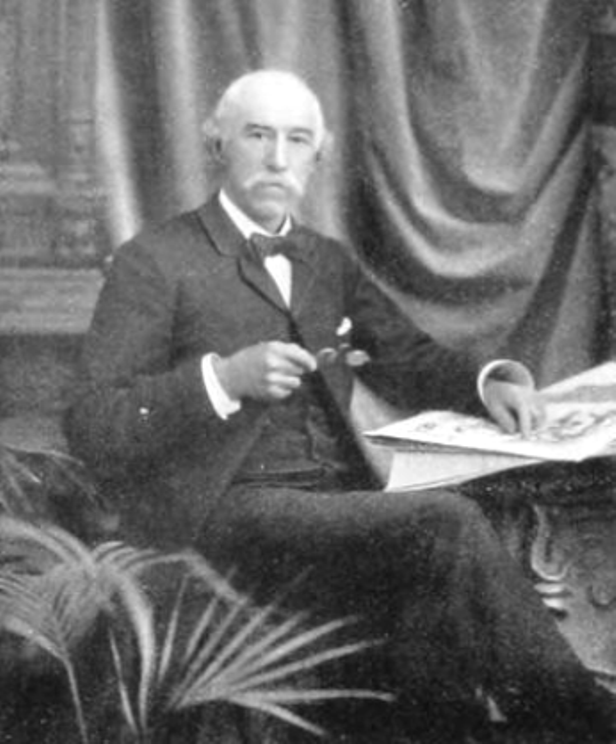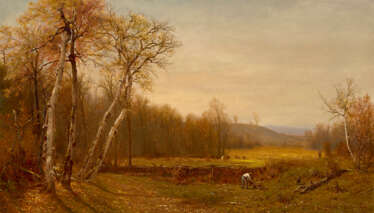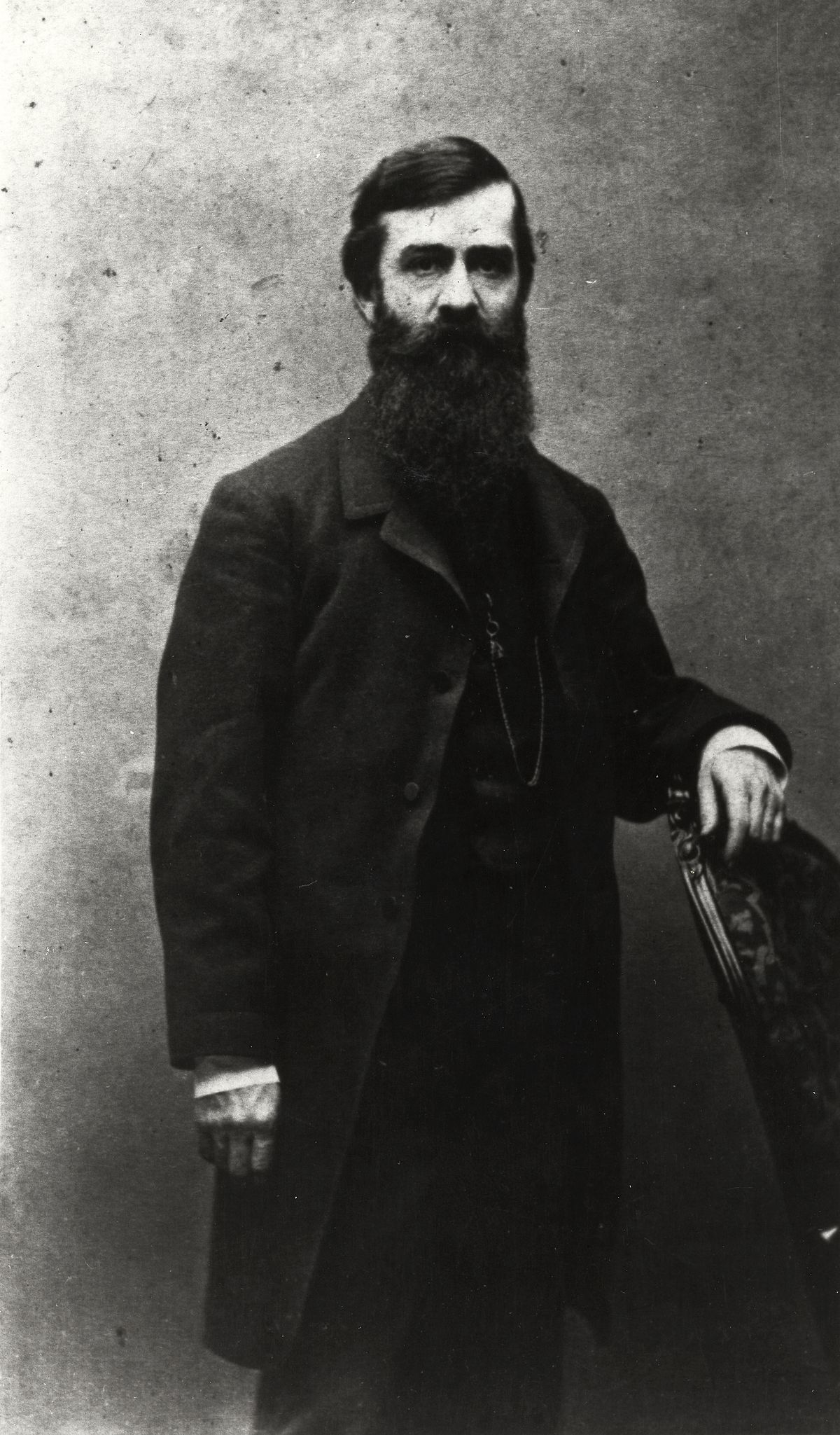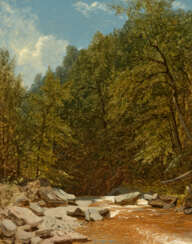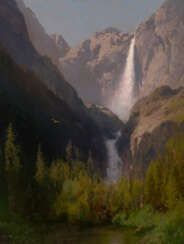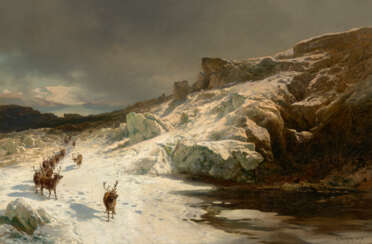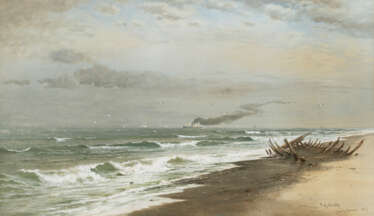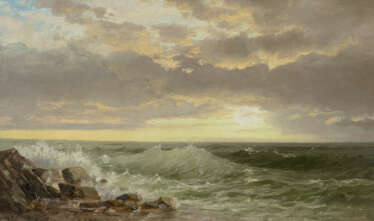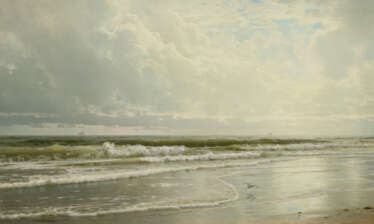
American Sublime: Property from an Important Private Collection
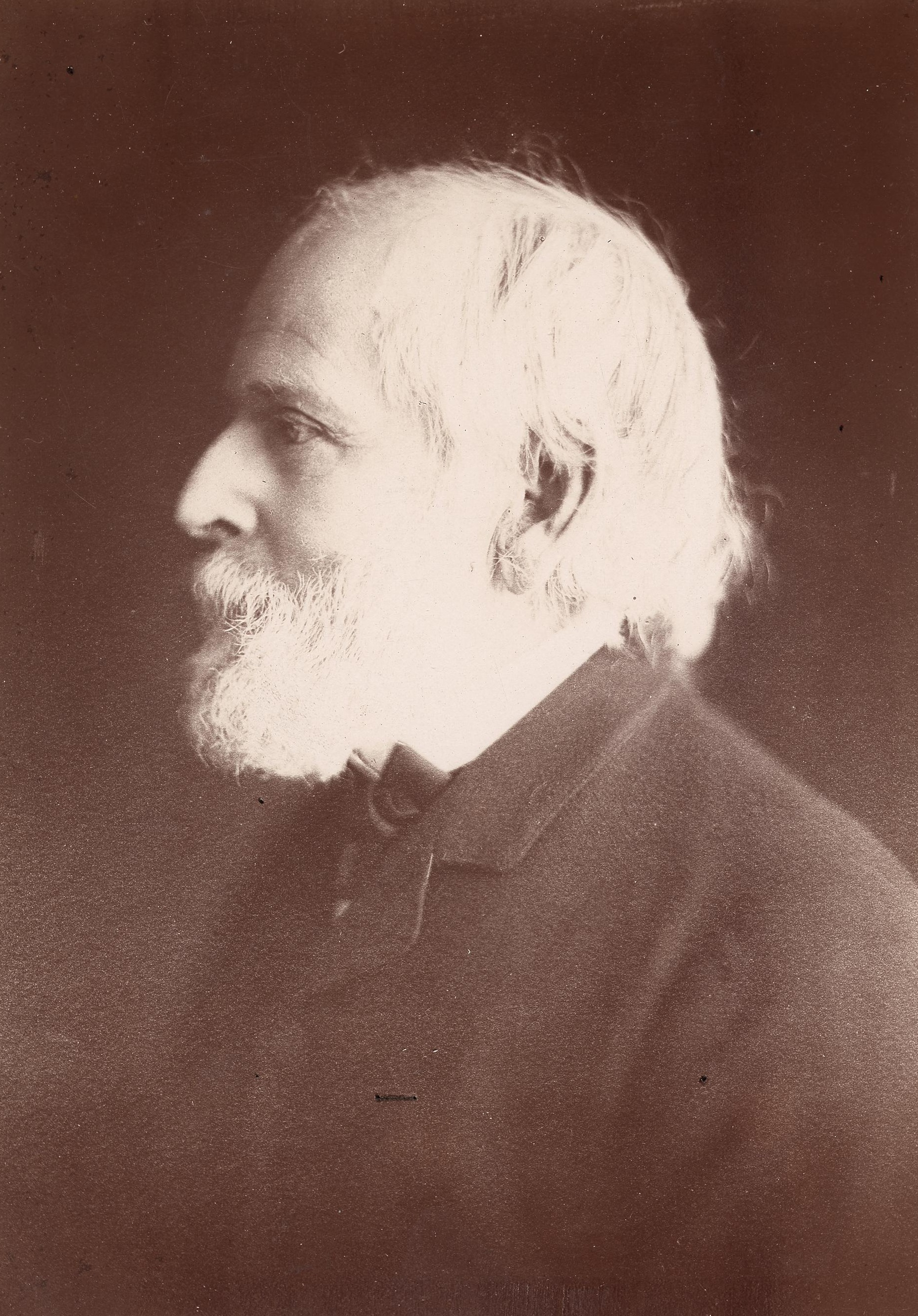
William Trost Richards was an American landscape artist. He was associated with both the Hudson River School and the American Pre-Raphaelite movement.
In the 1870s, he produced many acclaimed watercolor views of the White Mountains, several of which are now in the collection of the Metropolitan Museum of Art. Richards exhibited at the National Academy of Design from 1861 to 1899, and at the Brooklyn Art Association from 1863 to 1885. He was elected a full member of the National Academy in 1871.
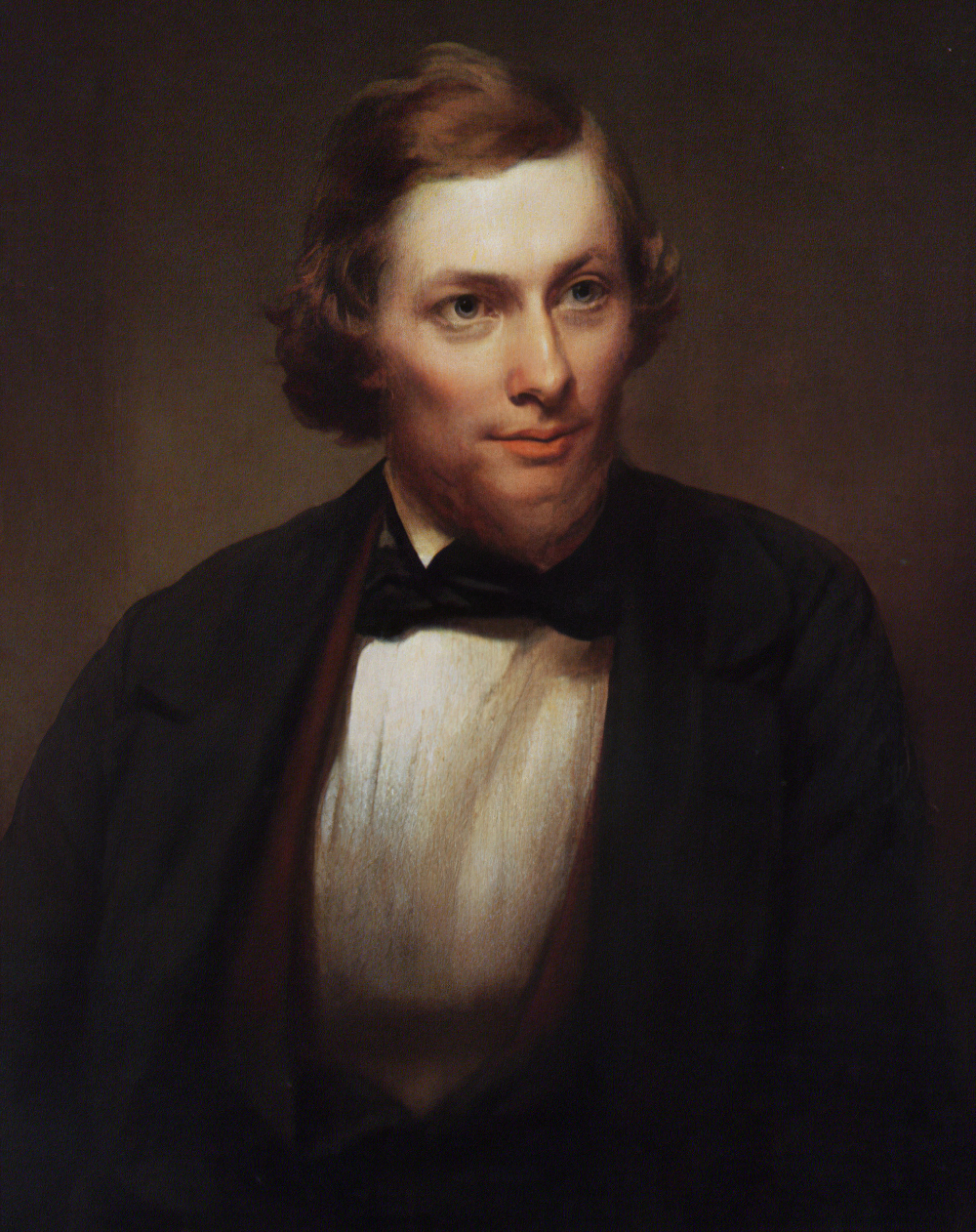
Jasper Francis Cropsey was an important American landscape artist of the Hudson River School.
Cropsey's interest in architecture continued throughout his life and was a strong influence in his painting, most evident in his precise arrangement and outline of forms. But Cropsey was best known for his lavish use of color and, as a first-generation member from the Hudson River School, painted autumn landscapes that startled viewers with their boldness and brilliance. As an artist, he believed landscapes were the highest art form and that nature was a direct manifestation of God. He also felt a patriotic affiliation with nature and saw his paintings as depicting the rugged and unspoiled qualities of America.
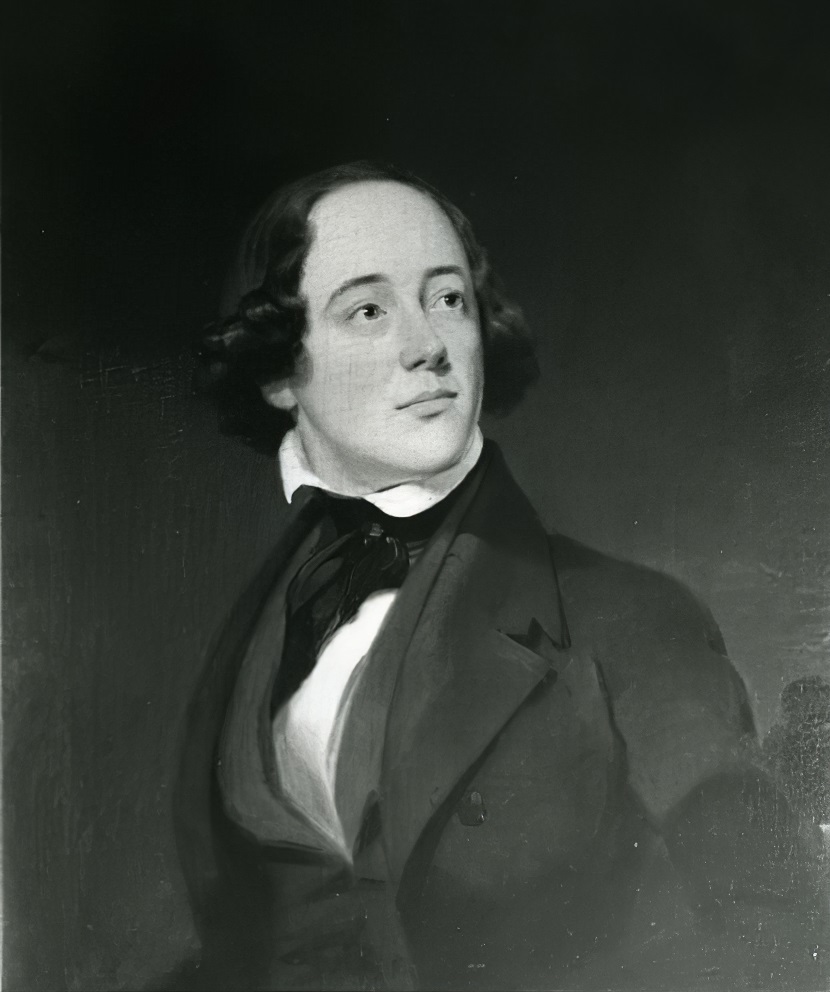
Martin Johnson Heade was an American painter known for his salt marsh landscapes, seascapes, and depictions of tropical birds (such as hummingbirds), as well as lotus blossoms and other still lifes. His painting style and subject matter, while derived from the romanticism of the time, are regarded by art historians as a significant departure from those of his peers.
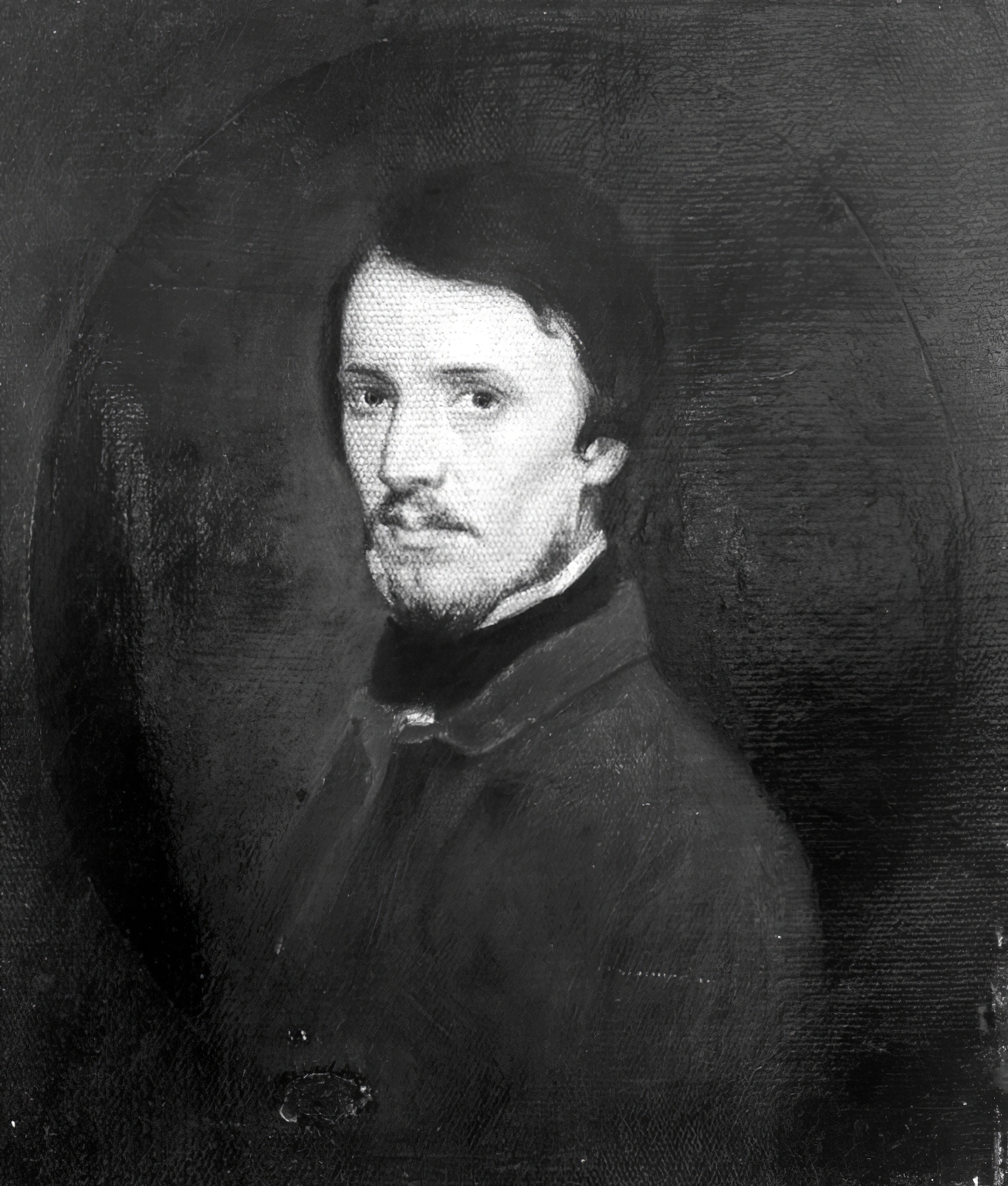
Sanford Robinson Gifford was an American landscape painter and a leading member of the second generation of Hudson River School artists. A highly-regarded practitioner of Luminism, his work was noted for its emphasis on light and soft atmospheric effects.
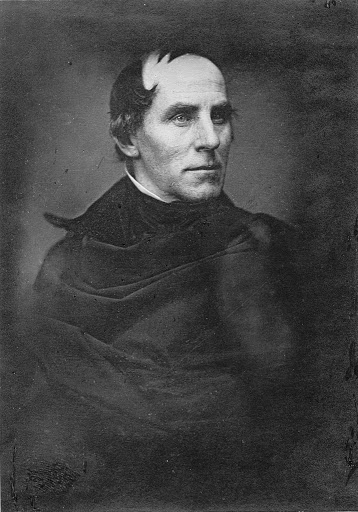
Thomas Cole, an English-born American artist, stands as a foundational figure in the Hudson River School, a movement that significantly shaped the course of American landscape painting. Born in Bolton-le-Moors, Lancashire, England, in 1801, Cole moved to the United States in 1818, where he embarked on a journey that would see him become one of the most influential artists of his time.
Thomas Cole's artistry is renowned for its romantic portrayal of the American wilderness, imbuing his landscapes with a spiritual and almost sublime quality that reflects his deep appreciation for nature. His works, such as "The Course of Empire" series and "The Voyage of Life," not only depict the beauty of the American landscape but also convey profound messages about humanity's relationship with the natural world. These series, showcasing the rise and fall of civilizations and the stages of human life against the backdrop of the natural world, highlight his philosophical and environmental concerns.
His technique of sketching directly from nature before creating detailed, idealized compositions became a hallmark of his style and influenced future generations of artists, including Frederic Edwin Church and Asher B. Durand. Thomas Cole's legacy extends beyond his paintings, as he played a pivotal role in the development of an art movement that celebrated the unique character of the American landscape, which was seen as a reflection of the nation's identity.
Thomas Cole's works are preserved in prestigious institutions like the New-York Historical Society, the Museum of Fine Arts in Boston, and the Metropolitan Museum of Art, serving as enduring testaments to his artistic genius and his profound connection to the American landscape.
For collectors and art enthusiasts, understanding Thomas Cole's influence and the themes he explored offers invaluable insights into the evolution of American landscape painting. If you're interested in staying updated on exhibitions, sales, and events related to Thomas Cole's works, consider signing up for updates to deepen your appreciation and knowledge of this iconic artist's contributions to American art and culture.
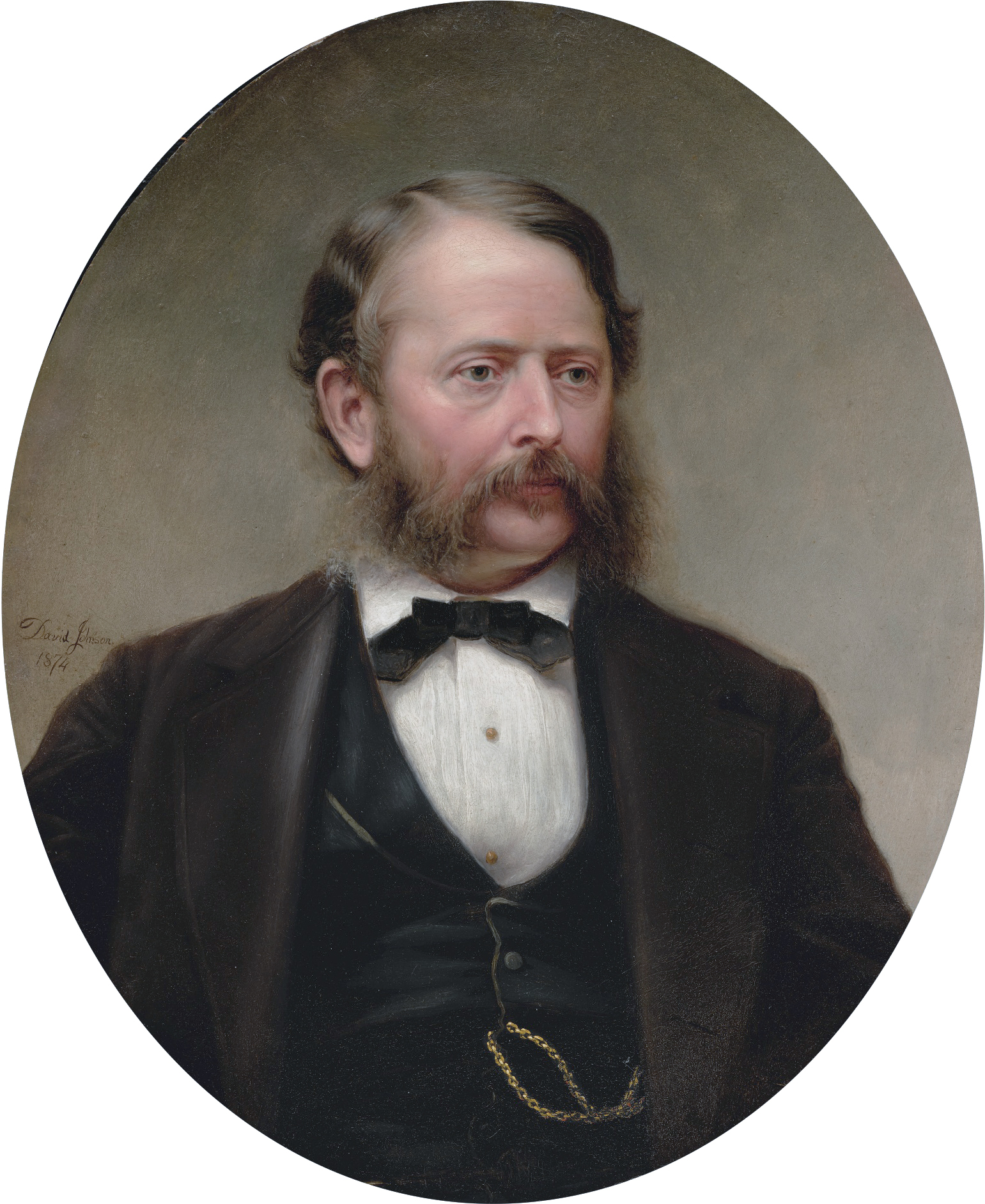
John Frederick Kensett was an American landscape painter and engraver born in Cheshire, Connecticut. He was a member of the second generation of the Hudson River School of artists. Kensett's signature works are landscape paintings of New England and New York State, whose clear light and serene surfaces celebrate transcendental qualities of nature, and are associated with Luminism. Kensett's early work owed much to the influence of Thomas Cole, but was from the outset distinguished by a preference for cooler colors and an interest in less dramatic topography, favoring restraint in both palette and composition. The work of Kensett's maturity features tranquil scenery depicted with a spare geometry, culminating in series of paintings in which coastal promontories are balanced against glass-smooth water. He was a founder of the Metropolitan Museum of Art.
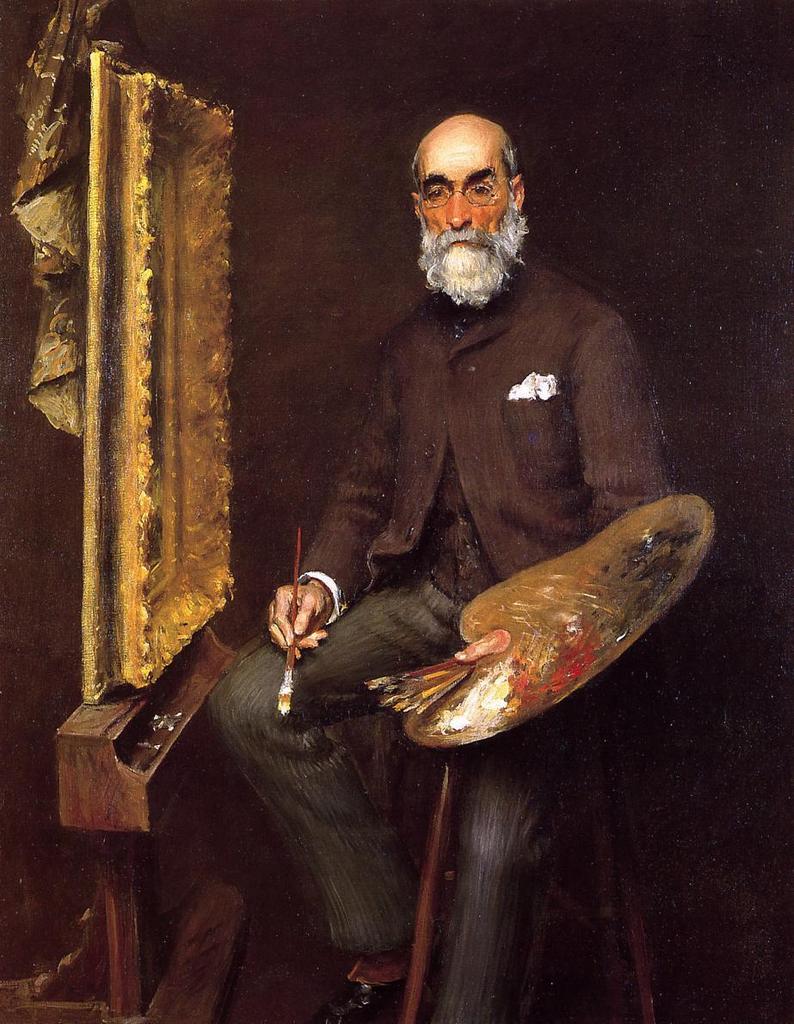
Thomas Worthington Whittredge was an American artist, a prominent figure of the Hudson River School, and is celebrated for his poetic forest scenes and serene landscapes. Born near Springfield, Ohio, Whittredge embarked on a journey that would see him become a household name in American art. His works are known for their depiction of the vastness and silence of the Plains, which he described as having a profound impact on him. He is particularly remembered for his trips to the West, which greatly influenced his art, leading to masterpieces that are treasured for their linear horizons and stark beauty.
Whittredge's legacy is preserved in the collections of esteemed institutions such as the Metropolitan Museum of Art in New York and the Louvre in Paris. His works, like 'The Trout Pool' (1870) and 'The Old Hunting Grounds' (1864), continue to enchant viewers with their tranquility and aesthetic appeal. His life, detailed in his autobiography, reflects a passionate dedication to capturing the essence of the American landscape.
For collectors, auctioneers, and experts in art and antiques, the works of Thomas Worthington Whittredge offer a timeless investment. His paintings are a testament to the Hudson River School's vision and skill, reflecting a deep connection to the American spirit. To stay informed about new product sales and auction events related to Whittredge, sign up for updates and ensure you don't miss the opportunity to own a piece of American art history.
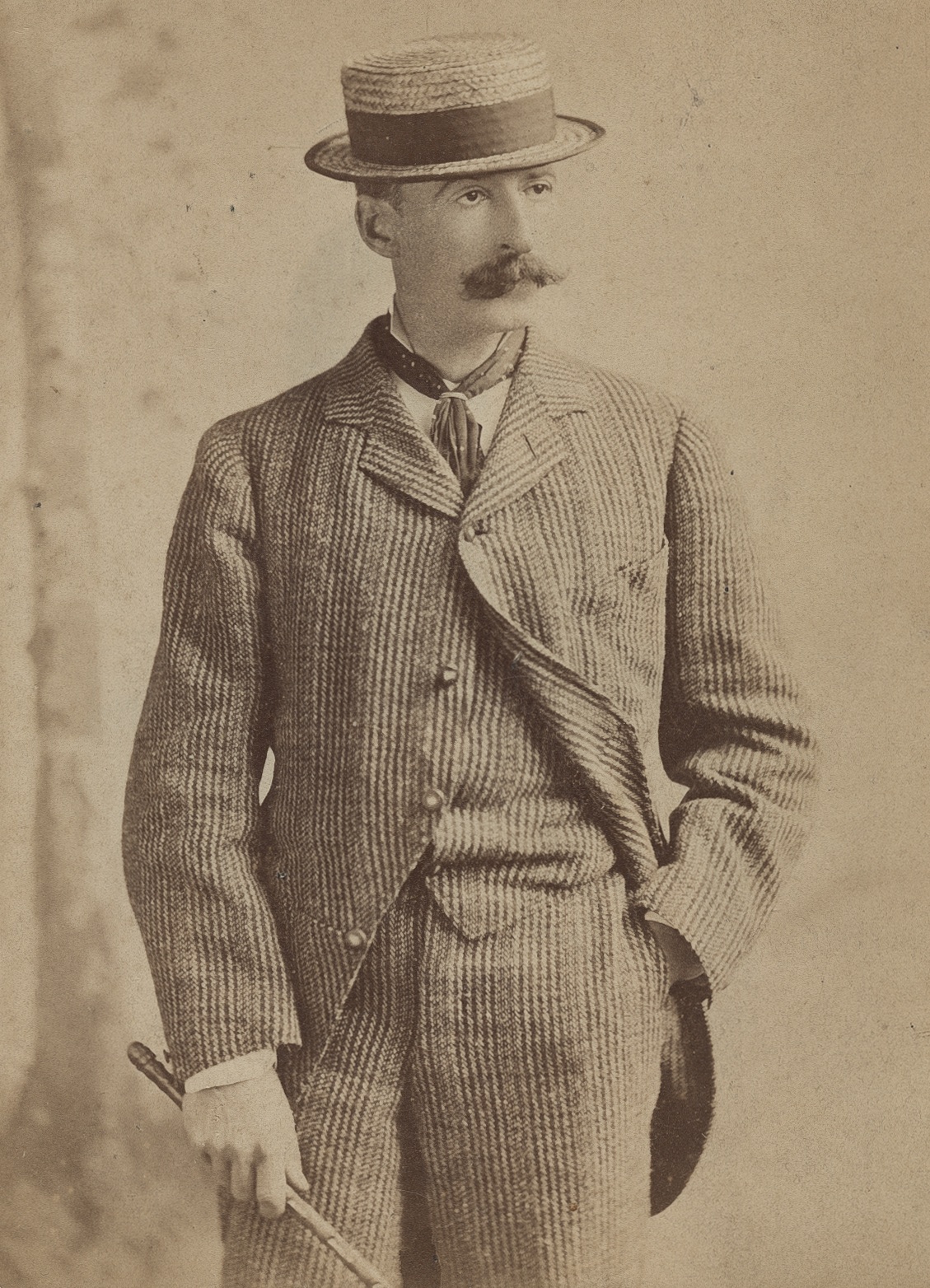
Winslow Homer was an American landscape painter and printmaker, renowned for his mastery of marine subjects and considered a preeminent figure in 19th-century American art. Born in Boston, Massachusetts in 1836, Homer was largely self-taught, starting his career as a commercial illustrator before venturing into oil painting and watercolors.
Homer's art evolved significantly over his lifetime. During the American Civil War, he worked as a correspondent, creating sketches that conveyed both the immediacy and the human cost of the war. This experience deeply influenced his later work, particularly his powerful oil paintings depicting war and its aftermath. After the war, Homer's focus shifted towards scenes of nature and rural America, reflecting a national nostalgia for simpler times. His works from this period, such as "The Cotton Pickers" and "Snap the Whip," showcase his ability to capture everyday life with poignant realism and emotional depth.
Later in his career, Homer became renowned for his watercolors and seascapes, such as "Breezing Up (A Fair Wind)" and "The Gulf Stream," which are celebrated for their dynamic composition and vivid portrayal of human interaction with nature. His late seascapes, which often depicted the rugged coastlines of Maine, are particularly noted for their dramatic intensity and hint at modernist abstraction, capturing the formidable power and timeless beauty of the sea.
Homer's works are held in high regard and continue to be featured in major museums and galleries, providing inspiration and insight into the American experience of the 19th century.
For those interested in the works of Winslow Homer and the impact of his art, you can sign up for updates related to new product sales and auction events featuring his work. This will keep you informed on opportunities to engage more deeply with Homer's enduring legacy.
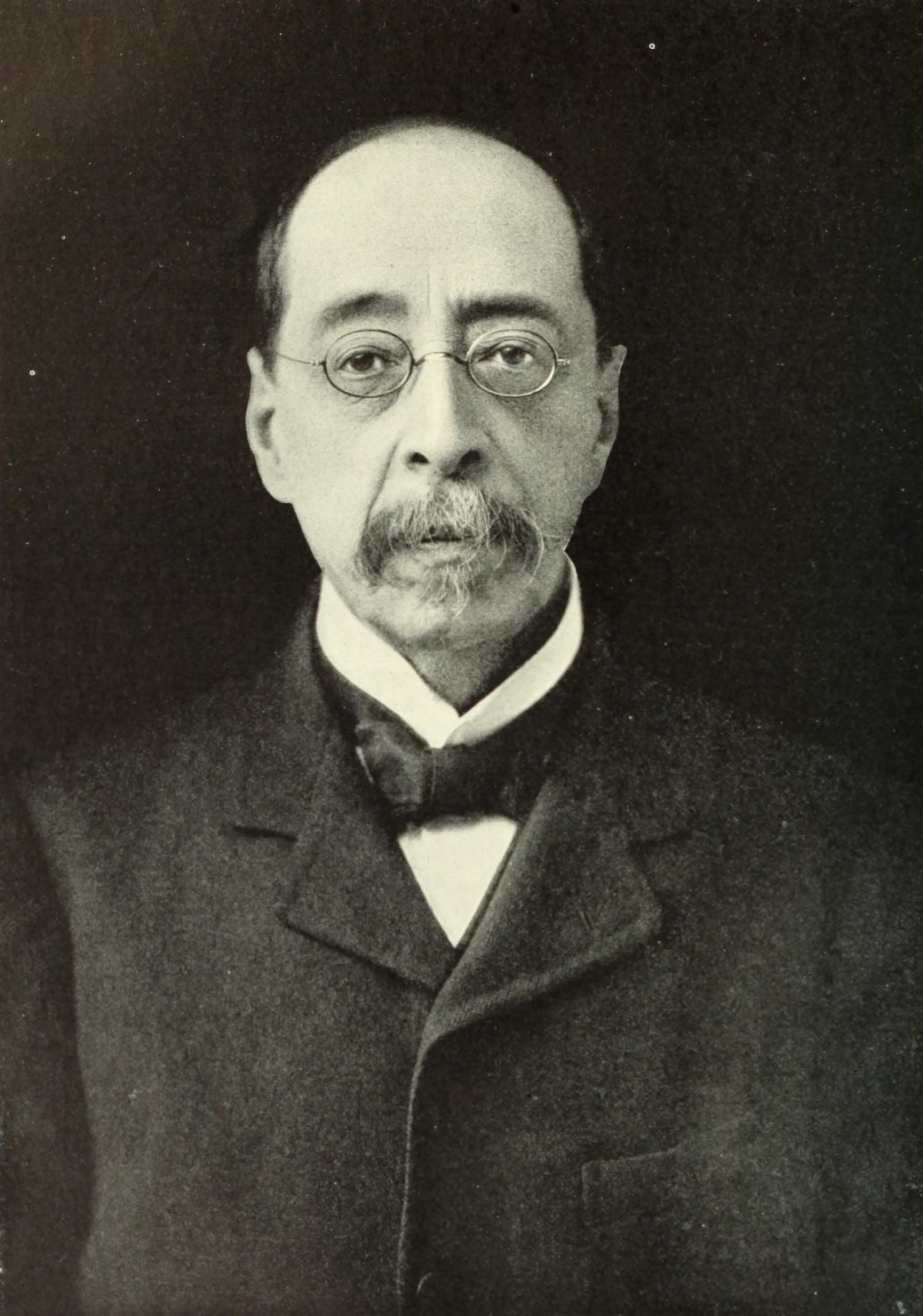
John La Farge was an American artist whose career spanned illustration, murals, interior design, painting, and popular books on his Asian travels and other art-related topics.
La Farge is best known for his production of stained glass, mainly for churches on the American east coast, beginning with a large commission for Henry Hobson Richardson's Trinity Church in Boston in 1878, and continuing for thirty years. La Farge designed stained glass as an artist, as a specialist in color, and as a technical innovator, holding a patent granted in 1880 for superimposing panes of glass. That patent would be key in his dispute with contemporary and rival Louis Comfort Tiffany.

John La Farge was an American artist whose career spanned illustration, murals, interior design, painting, and popular books on his Asian travels and other art-related topics.
La Farge is best known for his production of stained glass, mainly for churches on the American east coast, beginning with a large commission for Henry Hobson Richardson's Trinity Church in Boston in 1878, and continuing for thirty years. La Farge designed stained glass as an artist, as a specialist in color, and as a technical innovator, holding a patent granted in 1880 for superimposing panes of glass. That patent would be key in his dispute with contemporary and rival Louis Comfort Tiffany.
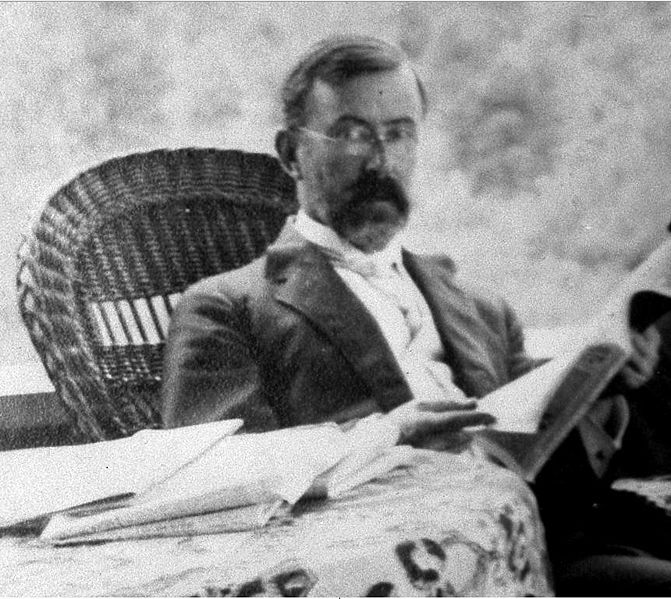
Charles Courtney Curran is an American impressionist painter.
He was educated at the National Academy of Design (New York), then studied at the Académie Julian in Paris.
Curran is known for his romantic depictions of young women in nature, where they are walking, playing sports or just admiring flowers. The artist also painted plein air, experimenting with a variety of artistic styles, including Impressionism, Symbolism, Tonalism and Naturalism.
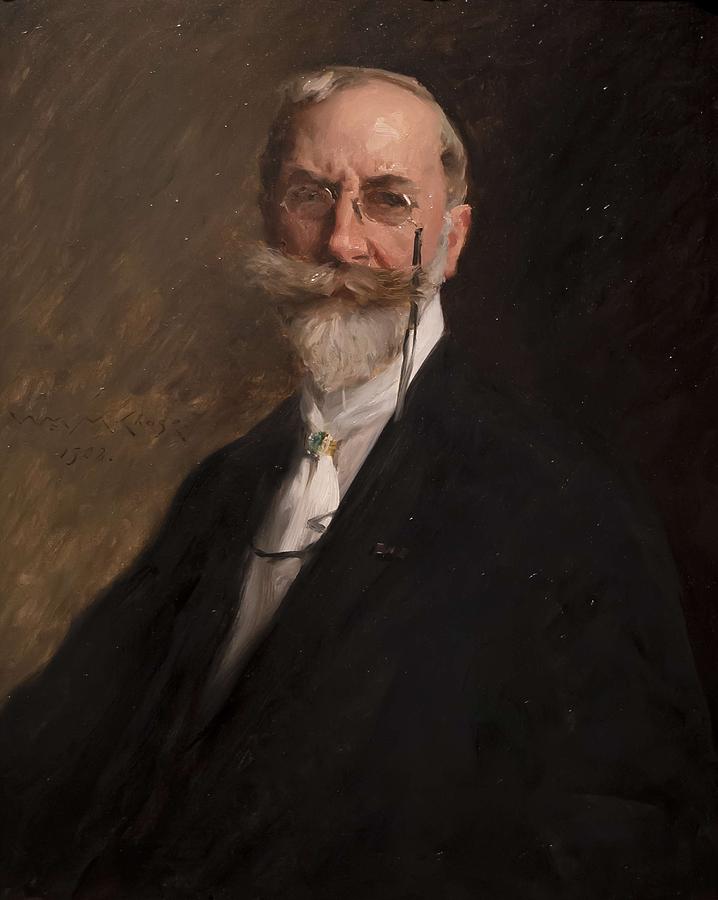
William Merritt Chase was an American painter, celebrated for his role in establishing Impressionism in America and his profound influence as an art educator. Born on November 1, 1849, in Indiana, Chase became a pivotal figure in American art, blending Impressionist and Realist styles with a distinctive flair that captured both cityscapes and intimate studio settings. His mastery of oil, pastel, and watercolor allowed him to create works renowned for their vibrancy and expressiveness.
Chase's career was notably marked by his transformation of studio environments into aesthetic showplaces, making them centers of social gatherings that enhanced his stature in the art community. His tenure at the Shinnecock Hills Summer School and his travels in Europe, especially his interactions with European artists, were crucial in shaping his artistic direction. Notably, his exposure to French Impressionism through exhibitions in New York profoundly influenced his style, integrating lighter palettes and freer brushwork which became evident in his landscapes and portraits.
Chase's works are celebrated for their innovative use of color and composition, qualities that made him a leading figure in American Impressionism. His notable works include scenes of everyday leisure, portraits, and vibrant landscapes, capturing the essence of his era with elegance and sophistication.
If you are intrigued by the artistic journey and impact of William Merritt Chase, consider signing up for updates. This subscription will keep you informed about new sales, upcoming auctions, and events related to his works. Stay connected with the vibrant world of William Merritt Chase and enhance your collection with knowledge and opportunities. Sign up today!
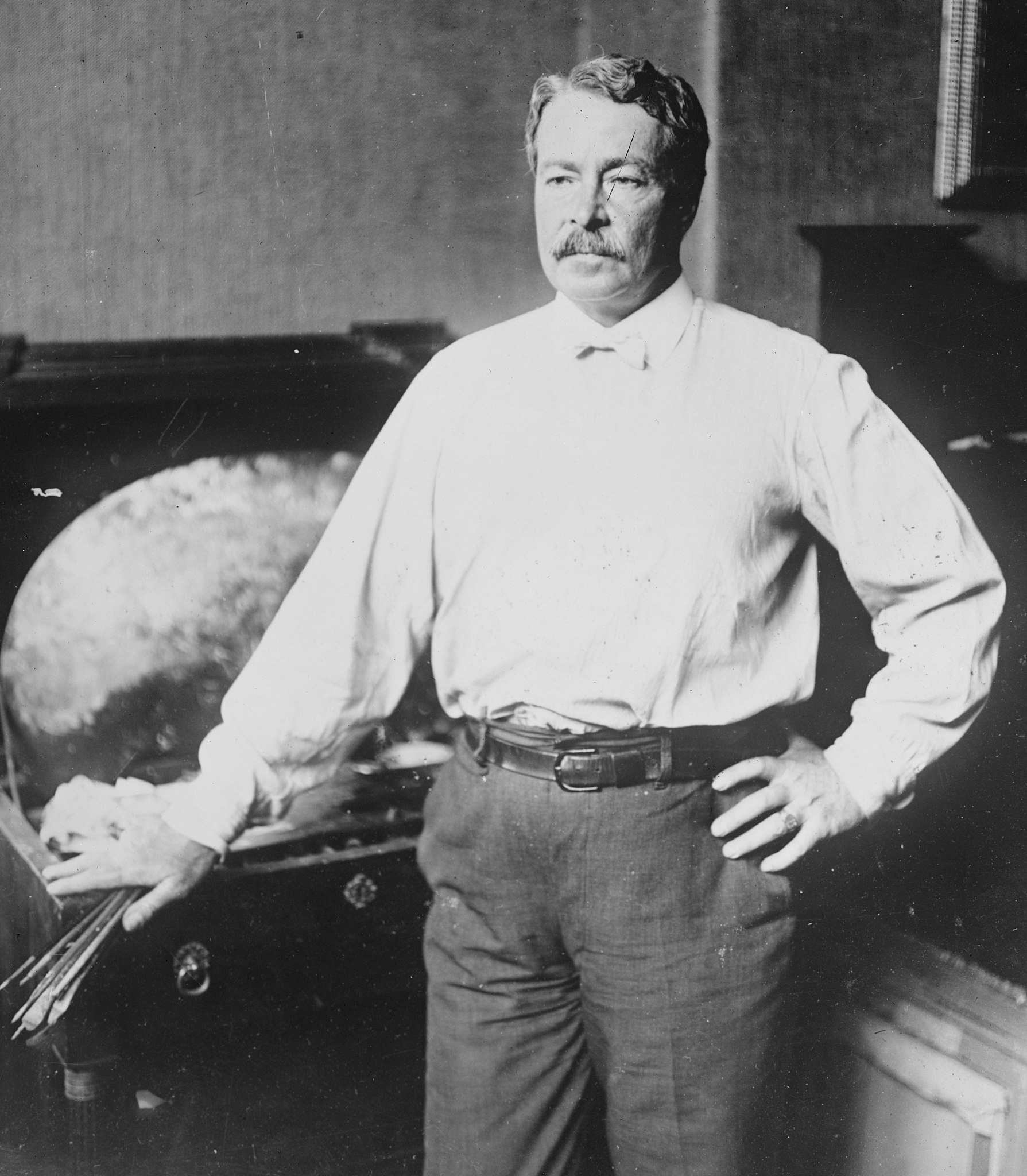
Frederick Childe Hassam was an American Impressionist painter, celebrated for his urban and coastal scenes. Born on October 17, 1859, in Dorchester, Massachusetts, Hassam was a pivotal figure in introducing French Impressionism to the American art scene. His prolific output includes over 3,000 works ranging from oils and watercolors to etchings and lithographs.
Hassam's technique was characterized by the use of light and vibrant colors, often focusing on bustling cityscapes and tranquil New England coastlines. He spent significant periods in Europe, particularly Paris, where he absorbed elements of the avant-garde styles of the time. Despite this, he often emphasized a connection to English landscape traditions over French ones.
Some of his most acclaimed works capture the essence of places like the Isles of Shoals in Maine and East Hampton in Long Island, where he later made his summer home. These settings often featured in his paintings, reflecting the picturesque and serene landscapes that contrasted with his urban subjects.
Hassam's legacy includes his influence on American collectors and institutions, helping to cultivate a taste for Impressionism in the United States. His works are held in major museums, including the Metropolitan Museum of Art and the Museum of Modern Art, ensuring his continued recognition as a key figure in American art history.
For those interested in exploring more about Hassam's life and works, signing up for updates on exhibitions and sales can provide valuable insights into his contributions to Impressionism. Subscribe for updates on new collections and auction events related to Frederick Childe Hassam's artworks.

Frederick Childe Hassam was an American Impressionist painter, celebrated for his urban and coastal scenes. Born on October 17, 1859, in Dorchester, Massachusetts, Hassam was a pivotal figure in introducing French Impressionism to the American art scene. His prolific output includes over 3,000 works ranging from oils and watercolors to etchings and lithographs.
Hassam's technique was characterized by the use of light and vibrant colors, often focusing on bustling cityscapes and tranquil New England coastlines. He spent significant periods in Europe, particularly Paris, where he absorbed elements of the avant-garde styles of the time. Despite this, he often emphasized a connection to English landscape traditions over French ones.
Some of his most acclaimed works capture the essence of places like the Isles of Shoals in Maine and East Hampton in Long Island, where he later made his summer home. These settings often featured in his paintings, reflecting the picturesque and serene landscapes that contrasted with his urban subjects.
Hassam's legacy includes his influence on American collectors and institutions, helping to cultivate a taste for Impressionism in the United States. His works are held in major museums, including the Metropolitan Museum of Art and the Museum of Modern Art, ensuring his continued recognition as a key figure in American art history.
For those interested in exploring more about Hassam's life and works, signing up for updates on exhibitions and sales can provide valuable insights into his contributions to Impressionism. Subscribe for updates on new collections and auction events related to Frederick Childe Hassam's artworks.
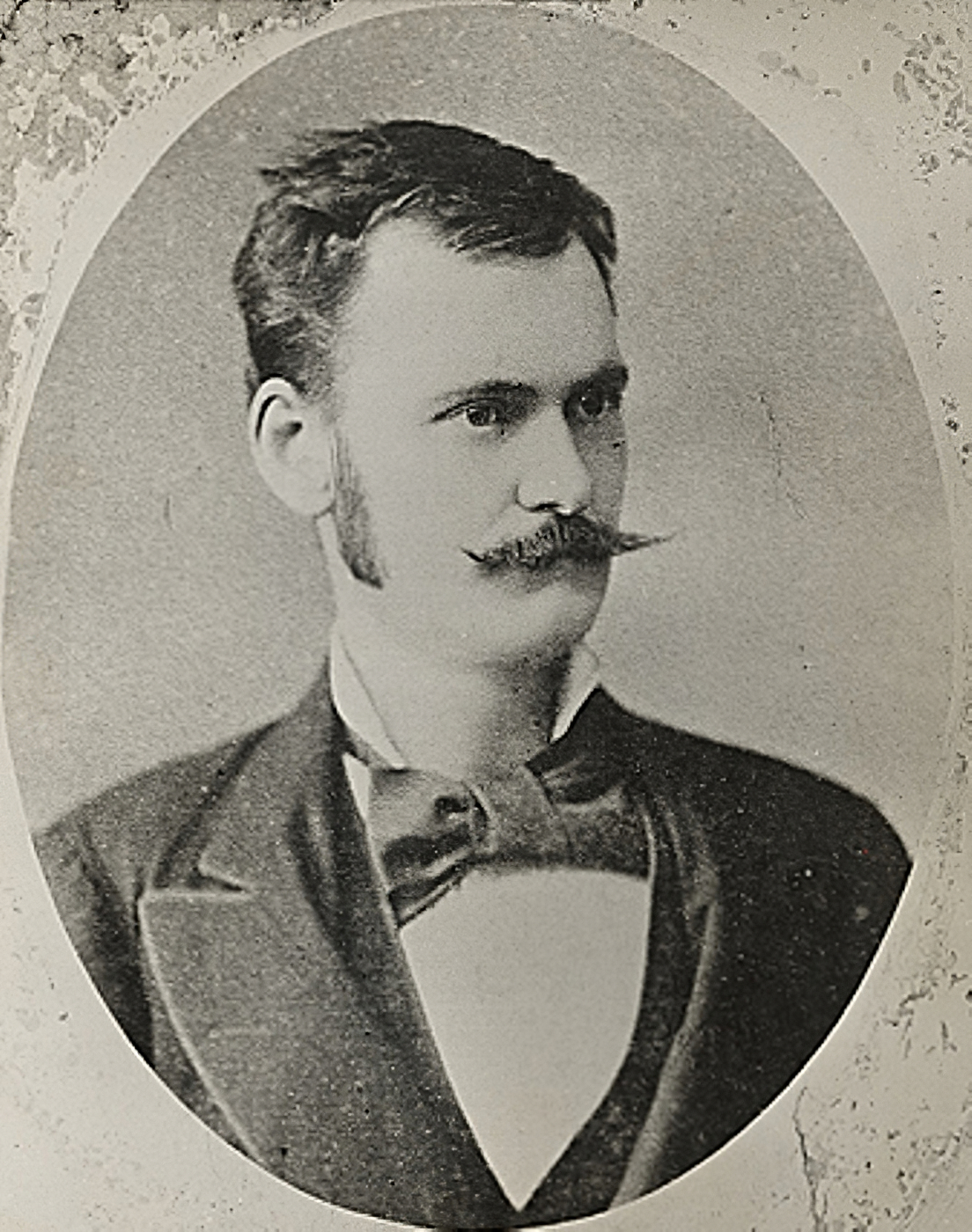
William Michael Harnett was an American painter of the second half of the 19th century. He became known as a master of still life. William Harnett was famous for his pictures of deception with extremely accurate depictions of everyday objects, which the viewer often could not distinguish from real things.
William Harnett, unlike most of his colleagues, never sought fame and popularity, so he forever remained faithful to the still life genre he had chosen as a young artist. His biography is a typical example of a successful career of a self-taught artist without academic education.
Harnett's best masterpieces are now preserved in museums in the United States.

Sanford Robinson Gifford was an American landscape painter and a leading member of the second generation of Hudson River School artists. A highly-regarded practitioner of Luminism, his work was noted for its emphasis on light and soft atmospheric effects.
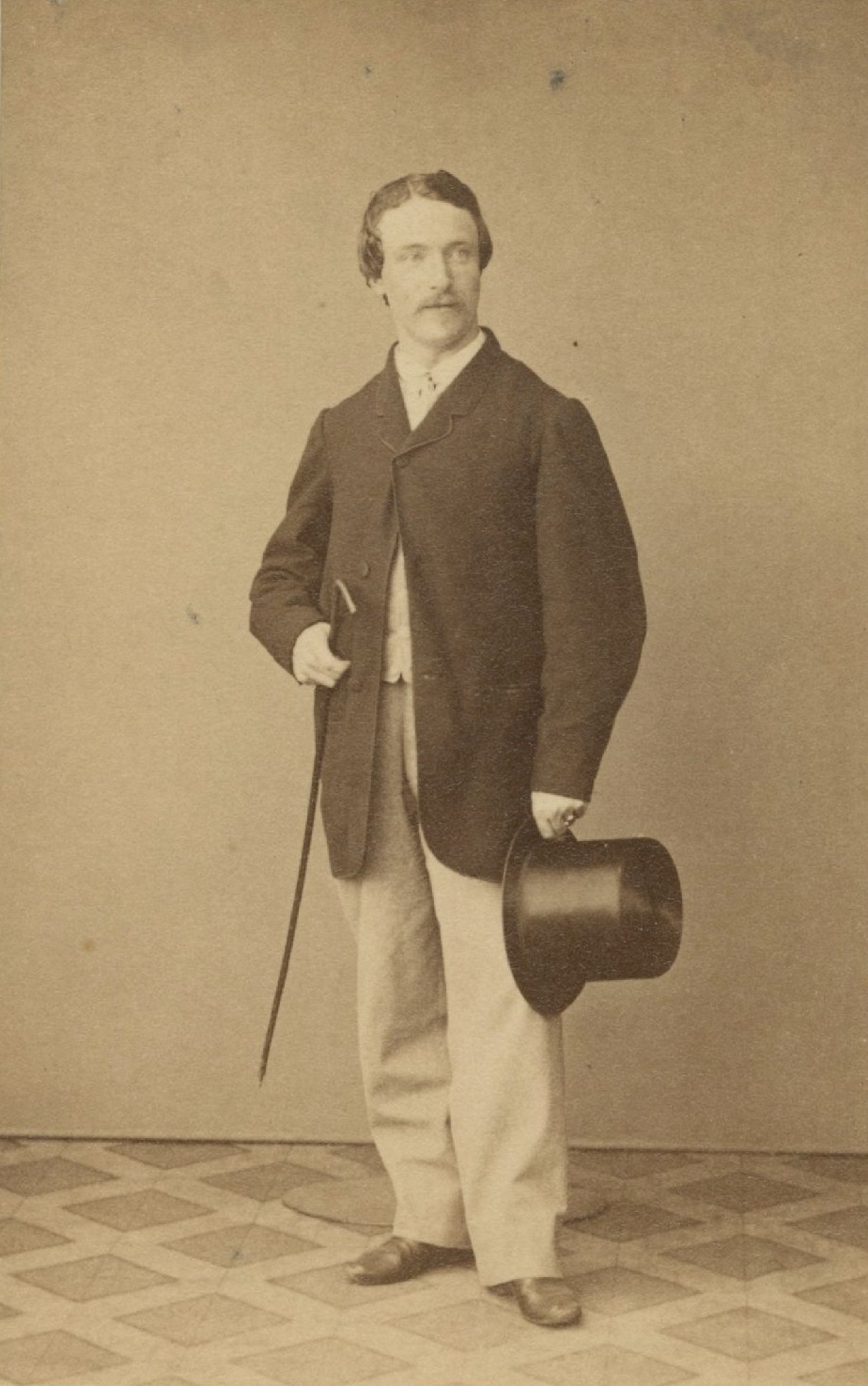
Hermann Ottomar Herzog was a German-born American landscape painter. He represented the Dusseldorf School of painting and was a member of the Hudson River School. He quickly achieved commercial success and began to earn good money, which allowed him to travel a great deal.
Herman Herzog settled in the United States at the end of the 1860s. He devoted a considerable part of his work to his journey through the western states to California in 1873. He also frequently visited and worked in Maine and Florida.

Hermann Ottomar Herzog was a German-born American landscape painter. He represented the Dusseldorf School of painting and was a member of the Hudson River School. He quickly achieved commercial success and began to earn good money, which allowed him to travel a great deal.
Herman Herzog settled in the United States at the end of the 1860s. He devoted a considerable part of his work to his journey through the western states to California in 1873. He also frequently visited and worked in Maine and Florida.
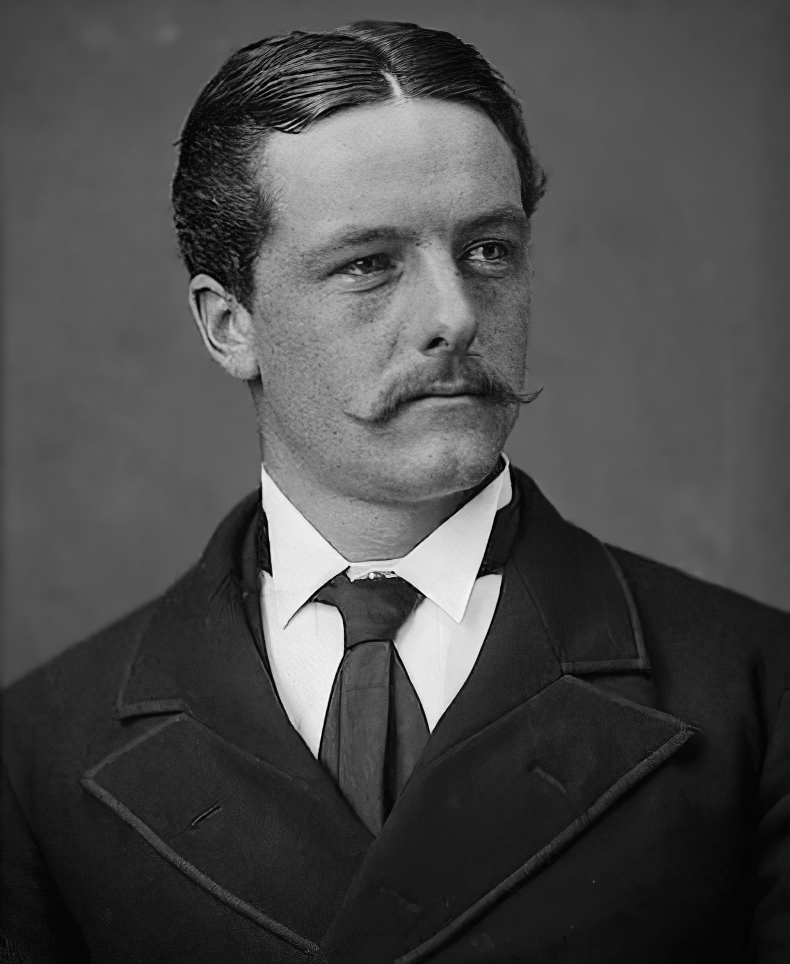
Francis Augustus Silva was an American Luminist painter of the Hudson River School. His specialty was marine scenes, particularly of the Atlantic coast, a genre in which he masterfully captured the subtle gradations of light in the coastal atmosphere. He focused on romantic scenes, avoiding depictions of seaside recreation, even when painting scenes at Coney Island, which was then already a popular recreational area.

William Trost Richards was an American landscape artist. He was associated with both the Hudson River School and the American Pre-Raphaelite movement.
In the 1870s, he produced many acclaimed watercolor views of the White Mountains, several of which are now in the collection of the Metropolitan Museum of Art. Richards exhibited at the National Academy of Design from 1861 to 1899, and at the Brooklyn Art Association from 1863 to 1885. He was elected a full member of the National Academy in 1871.

William Trost Richards was an American landscape artist. He was associated with both the Hudson River School and the American Pre-Raphaelite movement.
In the 1870s, he produced many acclaimed watercolor views of the White Mountains, several of which are now in the collection of the Metropolitan Museum of Art. Richards exhibited at the National Academy of Design from 1861 to 1899, and at the Brooklyn Art Association from 1863 to 1885. He was elected a full member of the National Academy in 1871.
